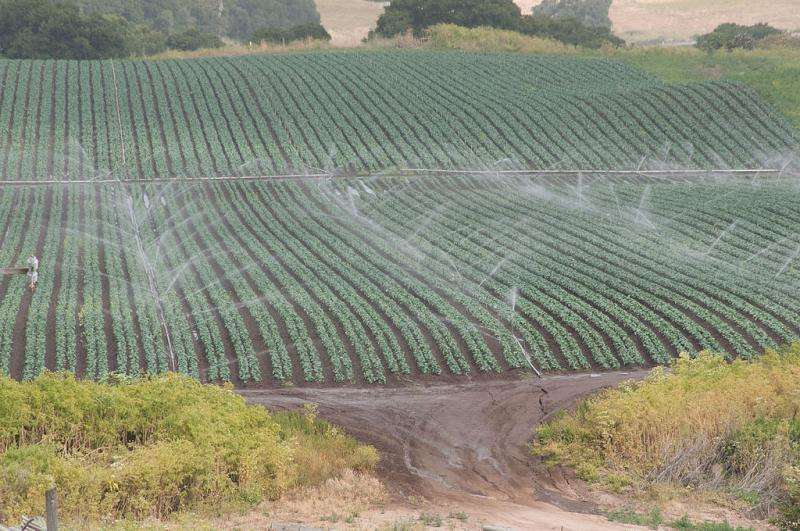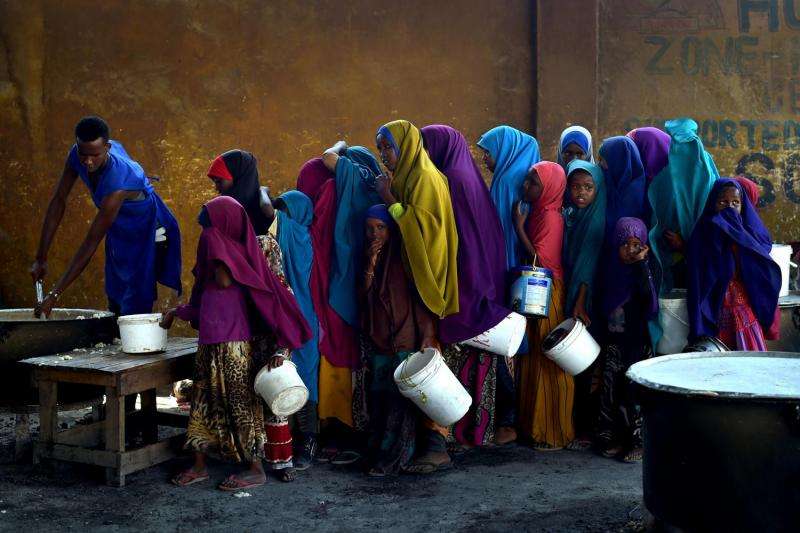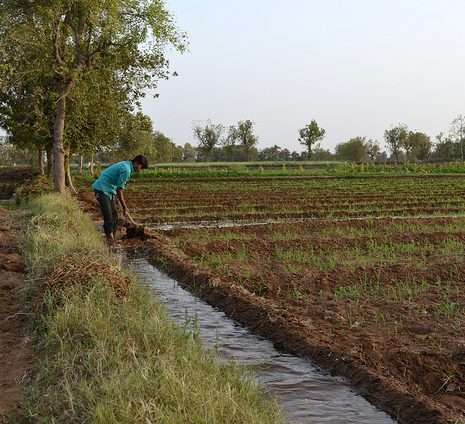Irrigation in Salinas, Calif. Depletion of groundwater resources in the United States and other major food exporters could eventually threaten food security around the world, a new study says. Credit: U.S. Department of Agriculture
Famine and starvation today threaten over 20 million people in four countries—Syria, Yemen, South Sudan and Somalia—the globe's largest humanitarian crisis in over half a century, according to the United Nations. Though this crisis is primarily the result of civil war and violent conflict, additional food security risks for the entire globe are hiding in the water use practices of major food producing nations.
In recent years, scientists have revealed that we are depleting our global groundwater reserves at an alarming rate. In some cases, these aquifer waters won't be replenished in this century, or ever. Now researchers from the U.S. and Europe have shown that a significant share of this unsustainable water use fuels the global food trade, which means water exhaustion in supplier nations could ripple outward, causing food crises half way across globe.
The research, published in Nature at the end of March, identified the countries that export and import the most food produced with non-renewable groundwater and the specific crops that rely most heavily on over-exploited aquifers. "We want to recognize that groundwater depletion is not a local issue," said Michael Puma, one of the authors on the paper and a researcher affiliated with Columbia University's Center for Climate Systems Research, the Center for Climate and Life and NASA's Goddard Institute for Spaces Studies. "It represents a stress on our global food supply."
Famine threatens over 20 million people in four countries, including Somalia, Syria, Yemen and South Sudan. Depletion of aquifers in major food producing nations could exacerbate the problem. Credit: UN / Creative Commons
Overall, approximately 11 percent of non-renewable groundwater used in irrigation is embedded in international food trade. (The other 89 percent goes to domestic food production.) The biggest exporters of food produced with non-renewable groundwater are Pakistan, India and the U.S., accounting for two-thirds of all such exports. The biggest importers of such food are China, the U.S., Iran, Mexico, Japan, Saudi Arabia, Canada, Bangladesh, the U.K. and Iraq. The crops most reliant on non-renewable groundwater are major staples such as wheat, rice, sugar, cotton and maize.
The researchers also highlighted the trade relationships that are most vulnerable to products produced with non-renewable groundwater. For instance, Pakistan's rice exports have more than quadrupled from 1990 to 2010 and drew a quarter of the country's non-renewable groundwater in 2010. These exports primarily go to Kenya, Bangladesh and Iran. Pakistan's rice exports have likely played a major role in depleting the country's aquifers, the researchers write, a process that should accelerate if population growth surges as projected at home and among importing partners over the next three decades.
Puma says he was shocked at the scale of the problem revealed in the results. Many of the countries that rely most heavily on overexploited aquifers also happen to be the world's biggest food producers: the U.S., Mexico, China, India. And the relationship between supply and demand in the global food trade is already tight. "So it's really troubling to look at this, on top of all of the challenges we face for the global food supply," he said.
Irrigation in Gujarat India is consuming groundwater faster than it can be normally recharged. The Columbia Water Center has been working with farmers and and local officials to encourage more sustainable water use. Credit: Jeremy Hinsdale, the Earth Institute
Non-renewable groundwater was defined as the volume of groundwater withdrawn for irrigation in excess of natural recharge rates and irrigation return flows, a calculation that has been made easier due to recent advances in water cycle modeling. The researchers relied on the PCR-GLOBWB model, an open source, large-scale hydrological model intended for global and regional studies developed at the Department of Physical Geography at Utrecht University in the Netherlands.
There is some uncertainty in the model, said Puma, because the rates of irrigation, rainfall, recharge, aquifer saturation, are all estimates. But the model itself has been verified using multiple datasets from both NASA and the U.S. Geological Survey, so the researchers have confidence in their results.
The paper recommends measures to address the problem for both importers and exporters. Food producing nations could implement water-saving strategies such as improvements to irrigation efficiency and a shift to more drought-resistant crops, together with irrigation metering and regulation of groundwater pumping. Importing countries could support sustainable irrigation practices in their trade partners. But more analysis needs to be done at the local level to understand the socioeconomic, cultural and environmental conditions that might shape policy responses.
"It's something that is poorly understood," said Puma. "We don't have many mechanisms, policy or otherwise, to deal with this."
More information: Carole Dalin et al. Groundwater depletion embedded in international food trade, Nature (2017). DOI: 10.1038/nature21403
Journal information: Nature
Provided by Columbia University
This story is republished courtesy of Earth Institute, Columbia University: blogs.ei.columbia.edu .
























